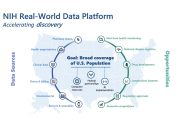
Non-white people will be prioritized for critical COVID treatments that are in short supply in states such as New York and Washington. Local health authorities claim that non-whites are at higher risk of COVID due to “systemic racism” and “long-standing inequities.”
New York
According to a document released by the New York Department of Health, “In times of limited supplies of monoclonal antibodies (mAbs) and oral antivirals (OAVs), providers should prioritize patients eligible for treatment based on their level of risk for progressing to severe COVID-19.”
The document notes that when estimating the patient’s risk of severe COVID outcomes, the healthcare providers must keep in mind that “Non-white race or Hispanic/Latino ethnicity should be considered a risk factor, as longstanding systemic health and social inequities have contributed to an increased risk of severe illness and death from COVID-19.”
The state health department provides a link to a U.S. Centers for Disease Control and Prevention (CDC) page that describes the underlying medical conditions associated with higher COVID risks.
Erin Silk, a spokesperson for the New York Department of Health, told Fox News that “the state’s ‘prioritization guidance comes directly from the CDC’ and that neither ‘race nor ethnicity would disqualify an individual from receiving treatment.’”
Not disqualifying, perhaps, but based on the memo, one’s race is now considered a contributing factor, along with age and comorbidities.
Silk further tried to explain, confusingly, that “Systemic poverty, which has clearly proven to be a risk factor in populations in New York State and nationwide, is added to the algorithm of prioritization similar to all other risk factors. It is merely mentioned as a factor that increases risk.” The memo, however, does not mention poverty or disadvantaged economic conditions, which affects representatives of all races living in New York.
Dr. Marc Siegel, a clinical professor of medicine and a practicing internist at New York University Langone Medical Center, called such a race-based approach to determining who gets COVID treatment first a “big embarrassment to the New York City Health Department and New York state.”
“We look at all humans the same,” he added. “That’s the therapeutic approach.”
The new provision is not only medically unethical, it is also unconstitutional.
“I believe New York’s noxious provision violates both the Fourteenth and Fifteenth Amendments, which respectively prohibit the denial of equal protection of law and the denial or abridgment of citizens’ rights based on race or color,” argued former U.S. Assistant Attorney Andy McCarthy.
Washington
According to the Washington Department of Health guidance on prioritizing administration of monoclonal antibodies, issued on December 28, 2021, “Among unvaccinated or partially vaccinated individuals (i.e., those who have either not completed a primary series and/or not up to date with a booster) with COVID-19, consider prioritizing administration to patients at highest risk for progressing to severe disease.”
The list of factors that increase COVID risks starts with “older age (e.g., > 65 years),” then goes on to list “limited access to care or members of communities disproportionately impacted by COVID19,” followed by such COVID co-morbidities as obesity, pregnancy, chronic kidney disease, diabetes, recently diagnosed hematologic malignancy, chemotherapy, solid organ transplant, cardiovascular disease or hypertension, chronic lung diseases, and numerous other conditions.
The guidance links to a CDC page entitled “Health Equity Considerations and Racial and Ethnic Minority Groups,” which notes that “The term ‘racial and ethnic minority groups’ includes people of color with a wide variety of backgrounds and experiences.”
The nation’s top healthcare agency further states that “Racism, either structural or interpersonal, negatively affects the mental and physical health of millions of people, preventing them from attaining their highest level of health, and consequently, affecting the health of our nation.”
It seems not to bother the CDC that declaring one’s race a determinant of whether he or she receives a medical treatment is a concept out of the racist playbook.
Minnesota and Boston
Minnesota posted similar eligibility requirements in December, saying that “Clinicians and health systems should consider heightened risk of progression to severe COVID-19 associated with race and ethnicity when determining eligibility for mAbs,” citing the FDA Fact Sheet for Health Care Providers from June 2020.
The document specifies that “available data show […] elevated risk of poor COVID-19 outcomes for Black, Indigenous and other people of color (BIPOC populations).”
Last March, doctors in Boston called for “preferential care based on race,” “race-explicit interventions,” and even “medical restitutions,” in a bid to “help to mitigate racial health inequities (including those seen in COVID-19).” The “anti-racist” doctors also suggested implementing standards that would show racial preference to patients, since they believed that “colorblind solutions have failed to achieve racial equity in health care.”
The CDC’s own data on “Demographic Trends of COVID-19 Cases and Deaths in the U.S. for COVID-19 hospitalization and death data by race/ethnicity,” however, does not indicate any “increased COVID risks” among non-white people.
Thus, among all COVID cases where race was recorded, 55.6 percent were white, 24 percent were Hispanics, and 11.9 were black.
At the same time, 62 percent of all COVID deaths were white, 17.2 percent were Hispanics, and 13.5 were black.
All those numbers closely correlate with the proportion of the population the race groups represent: 60.11 percent (whites), 18.45 percent (Hispanics), and 12.54 percent (blacks).





